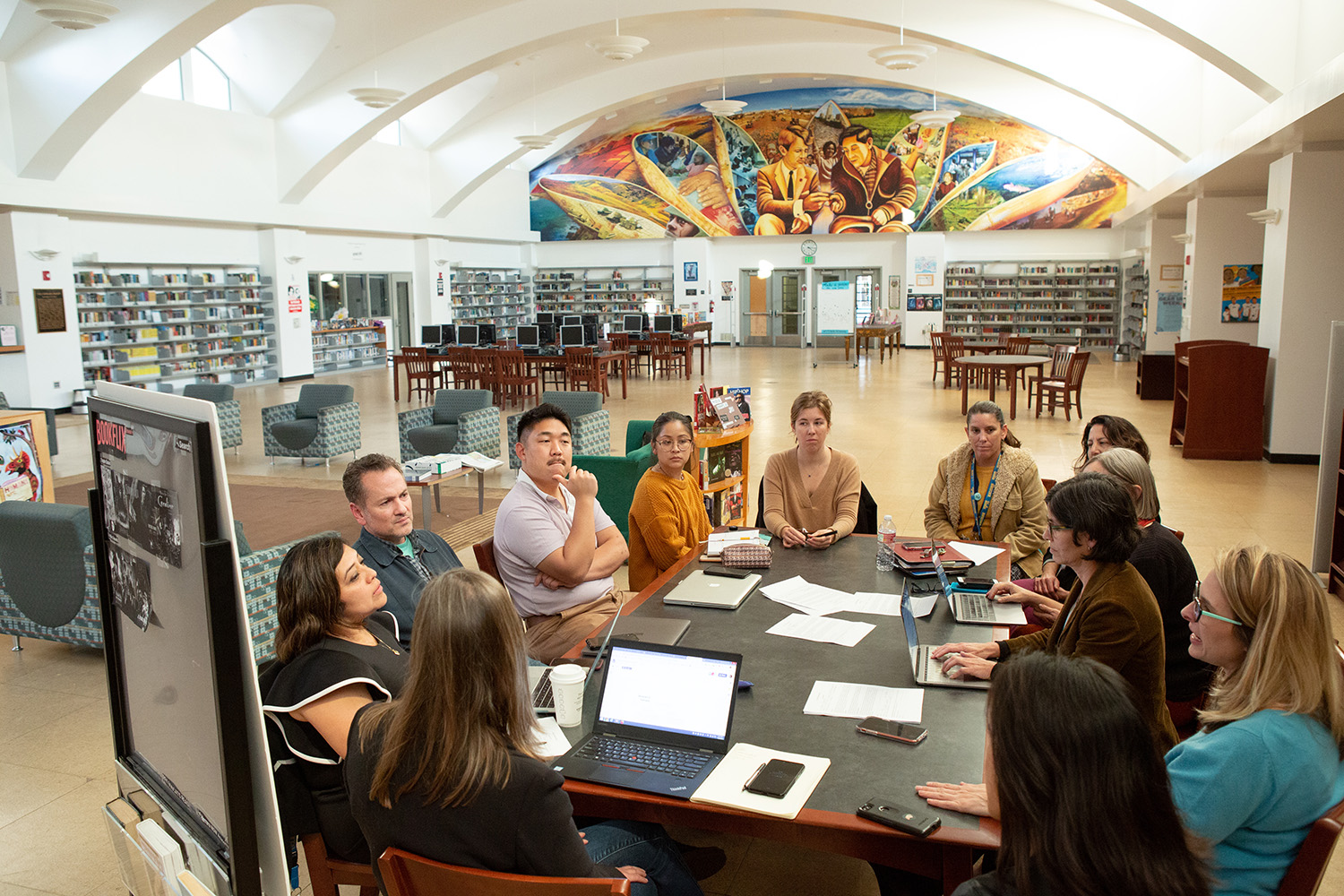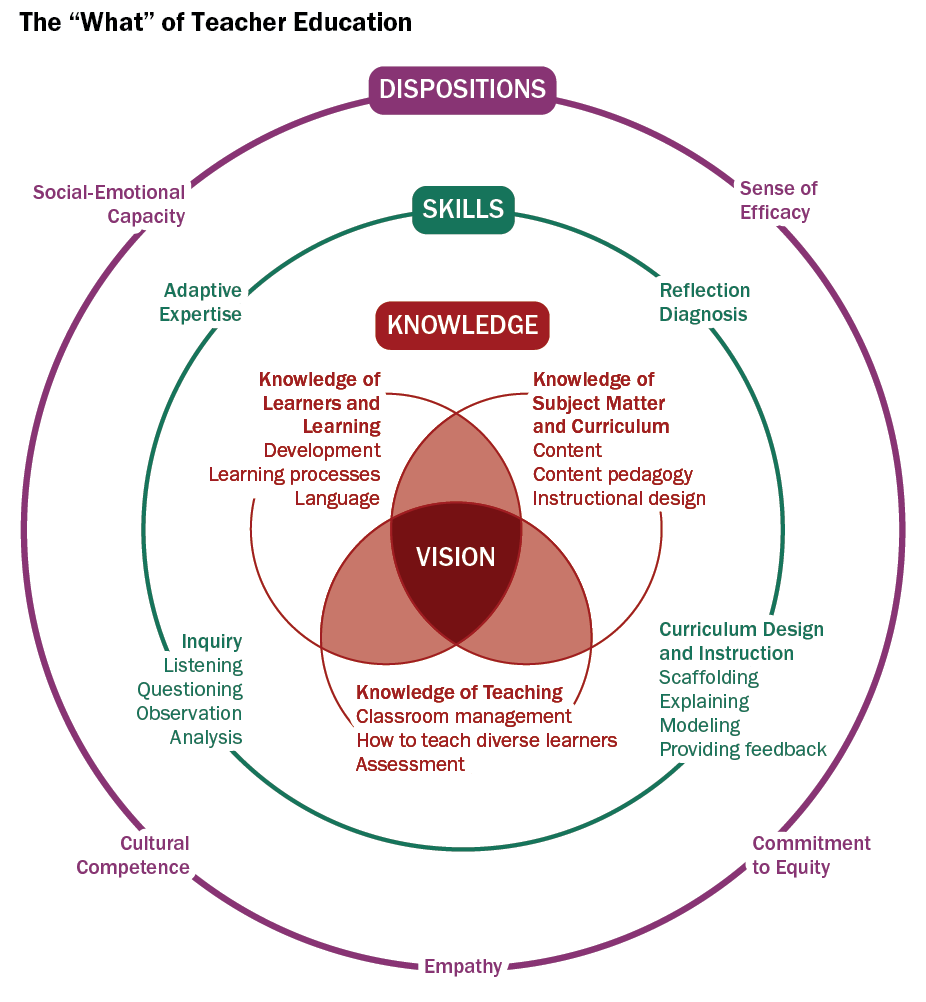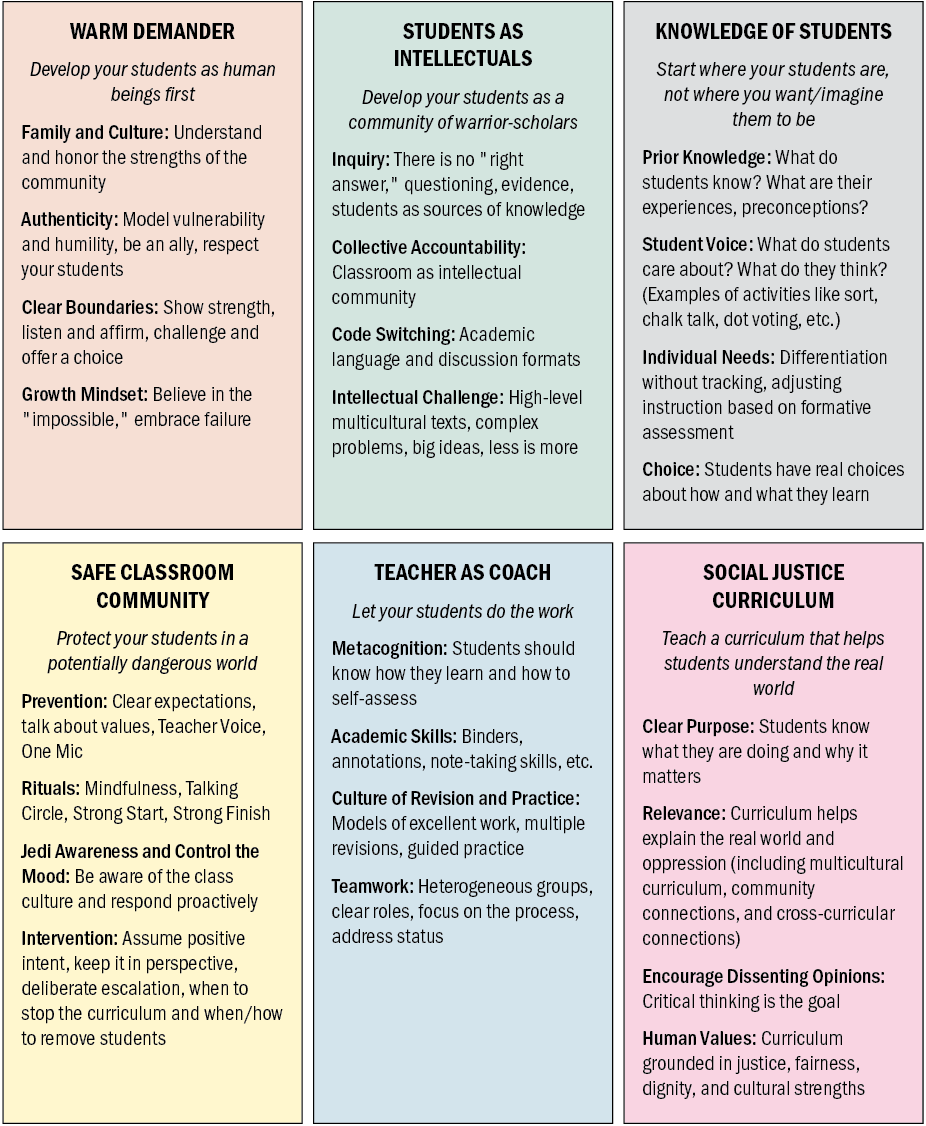“[When] you’re in isolation and you’re just doing stuff in your classroom, you don’t know if it’s good. You don’t know if you’re actually having an impact. But when you can share it out with other teachers and get their ideas, it becomes not my idea but our idea. And if I’m struggling, I have someone who can support me on it.”
Teacher in Madera, CA114
What Students Need
A substantial body of research suggests that one of the most important school determinants of student achievement is the quality of teachers.115 A recent study of California districts that are “positive outliers” in terms of student achievement for Black, Latino/a, and White students found that key factors in their success were teachers’ strong preparation, their stability, and the opportunities they had for professional collaboration, with strategies for developing common norms and practices and sharing them systemwide.116
Teaching in ways that connect with each student and enable them to learn deeply is one of the most complex and difficult jobs there is. As one recent entrant to the profession noted:
You can be a mediocre to poor teacher very easily. And in that case, I think it’s a simple job. But to be a good teacher and one that expands and keeps learning, it’s the hardest job I’ve ever done—and I’ve done a lot of jobs. … I had no idea how complex it was and how much of a profession it is.
It is even more difficult to do this job in the factory-model design that created “egg-crate” classrooms in which teachers are lone operators who stamp students with a lesson as they stop in during 5 or more periods a day. With little collaboration and planning time, and few deep learning opportunities themselves, U.S. teachers in traditional high schools have one of the most difficult teaching jobs in the industrialized world.
Compared to teachers in more than 50 other countries surveyed by the Organisation for Economic Co-operation and Development (OECD) in 2018, for example, U.S. teachers were among those who taught the most hours per week and year and had among the least planning time. U.S. teachers worked directly with students about 50% more hours than the international average, leaving them 8 fewer hours per week for nonteaching tasks, such as collaborative planning and professional development, reaching out to parents and students one-on-one, or assessing student work.117 (See Figure 7.) U.S. teachers also had above-average class sizes118 and taught more students from low-income families than teachers in most other OECD countries.119
Redesigned high schools take a different approach, investing deeply in training and supporting their teachers and providing them with time and opportunities to create a coherent set of practices and become experts at their craft. Teachers with these opportunities are more effective and likely to stay for the long run, with a payoff in student achievement.120
Figure 7. U.S. Teachers Teach More Hours per Week Than Teachers in Other Countries

Source: Organisation for Economic Co-operation and Development. (2018). Teaching and learning international survey.
Key Practices
Teacher Preparation
If teachers are viewed primarily as transmitters of information to students, one could argue that they need little more than basic content knowledge and the ability to string together comprehensible lectures to do an adequate job. But if teachers are to ensure successful learning for students who learn in different ways and encounter a variety of challenges, then they must be prepared as diagnosticians, planners, and leaders who know a great deal about the learning process and have a wide repertoire of tools at their disposal.
There are three key areas in which teachers must be experts: (1) their subject matter and curriculum, (2) the needs of diverse learners and the learning process, and (3) teaching itself. Teachers not only need to know the subject matter in their content areas well; they also need to know how to access curriculum resources and how to represent the ideas in their content areas so they are accessible to others.
Teachers also need to understand the needs of diverse learners and the learning process. This includes knowing about child and adolescent development—including how young people’s cultures, languages, and experiences affect them—as well as how multiple intelligences and learning differences shape their approaches to school and learning. Each student has a unique mind, and teachers must know how to figure out how students are thinking and learning so they can shape lessons to connect with what students already know and how they learn well. They need to know what motivates people to learn and how people learn in different ways and for different purposes. No matter what content area they are teaching, they must understand language learning and literacy development, which are at the heart of the learning process for all students, especially English learners, who must learn how to communicate in English while they are simultaneously learning content.

Teachers must have deep knowledge about teaching itself, which is very complex, involving the development of a safe learning community, the use of a range of pedagogies to meet disciplinary demands and student needs, and skillful use of assessment to identify students’ strengths and needs and help them learn more effectively.
In addition to these areas of knowledge, teachers must develop skills such as adaptive expertise, inquiry and reflection, and curriculum design, which allow them to listen to and observe what is happening in the classroom on a daily basis and make adjustments to lessons and units to ensure that their students are learning. To accomplish this, teachers must possess and develop dispositions including empathy, social-emotional capacity, cultural competence, and a commitment to equity.121 (See Figure 8.)
Teachers who enter teaching without adequate preparation and who do not receive adequate supports often wind up stereotyping and blaming the students whom they do not understand, especially when their own lack of skills renders the teacher less successful. One teacher who entered teaching through a short summer training program explained: “I found myself having problems with cross-cultural teaching issues, blaming my kids because the class was crazy and out of control, [and] blaming the parents as though they didn’t care about their kids.”122 This teacher later entered a teacher education program and found that the tools she acquired transformed her ability to reach her students. Students need access to teachers who themselves have access to knowledge about how to implement a culturally responsive pedagogy that supports students from diverse backgrounds. (See Feature 3: Culturally Responsive and Sustaining Teaching.)
Effective schools and districts do not leave teacher hiring to chance. They devote resources and attention to recruiting well-trained educators, often by establishing professional development school partnerships with local teacher education programs. Teachers who enter with comprehensive preparation are half as likely to leave teaching after the first year than those who enter without preparation. Grow Your Own pathway programs, including paraprofessional pathways and teacher residencies, can support local community members to become effective teachers and provide opportunities for seamless support for new educators, starting during their student teaching and continuing with intensive coaching and mentoring during their initial years in the classroom. These programs, especially when combined with adequate financial supports, can make entering teaching more affordable and reduce attrition while developing a highly skilled teaching force.
Figure 8. Knowledge, Skills, and Dispositions for Teaching

Source: Darling-Hammond, L., Flook, L., Schachner, A., & Wojcikiewicz, S. (with Cantor, P., & Osher, D.). (2022). Educator learning to enact the science of learning and development. Learning Policy Institute.
Ongoing Learning for Teachers
Effective teachers are not only well prepared; they are also continually learning. Redesigned schools commit serious time and resources to collaborative planning and ongoing professional development. This supports both more thoughtful and effective teaching within the classroom and greater coherence across courses and grade levels, with associated gains in achievement.123 Without expert teachers who are continually learning and growing as professionals, much of the other work that schools seek to do cannot be successful.
Teachers in factory-model schools have often experienced professional development in the form of one-time “sit and get” sessions that are disconnected from their daily practices or their individual needs. However, effective professional development is quite different. From studies that document teacher learning–associated gains in student learning, researchers have learned that effective professional development:
- is content focused;
- incorporates active learning utilizing adult learning theory;
- supports collaboration, typically in job-embedded contexts;
- uses models and modeling of effective practice;
- provides coaching and expert support;
- offers opportunities for feedback and reflection; and
- is of sustained duration.124
Effective schools design professional learning along these lines, creating adult learning experiences that not only enable teachers to expand their repertoires to help students learn more but also provide opportunities for school staff to revisit the school’s vision and goals, develop a collective perspective on teaching practice—which creates a more coherent experience for students—and create a stronger school culture. They also provide time for teachers to plan curriculum together and talk together about individual students to determine how to best support them. Consistent high-quality teaching across a school is developed by creating a deliberate repertoire of strategies and a well-sequenced plan for content that connects to students’ prior learning, and doing so in collaboration with other faculty so that knowledge is shared.
Time for Teacher Collaboration
This work is made possible by building in significant time for teacher collaboration during the workday to allow for joint planning and learning. However, in many American schools, teachers spend their Sunday nights sitting at their kitchen tables, all by themselves, inventing their lessons for the week.
The scientific managers who created the factory design felt that teachers are only working when they are alone in their classrooms, stamping students with lessons on the conveyor belt of the industrial-model school. The presumption of the assembly line school was that teachers would not need time to plan or evaluate their teaching, because they would merely march through the lessons in a prescribed curriculum. Expertise in teaching—as in many other fields—comes from a process of sharing, attempting new ideas, reflecting on practice, and developing new approaches. Good teachers constantly learn with and from one another, and they need time to do it. As a teacher in one New York City redesigned school put it:
Now that the schedule allows teachers to meet, we help each other. We write curriculum together. The variety of work we do with students is greater. … Teachers share what they are doing in a formal way in team meetings. They plan together and share what they have done. There is whole school sharing and there are summer institutes where we have more time to reflect. There is more coherence than in schools where teachers work alone.125
As noted earlier, this shared planning is something that many other countries and some schools in the United States build into their structures for schooling. On average, teachers in OECD countries spend about 19 hours of a 40-hour work week in their classrooms with students. Thus, they have 20 hours or more per week to plan lessons, to meet with students and parents, and to work together and learn from one another. This collaborative work includes developing curriculum and assessments, observing each other’s classes, and participating in study groups and other professional development activities.
The results of this collaboration are seen in improved student outcomes, both in other countries and in the many redesigned schools in the United States that have prioritized teacher expertise. They have demonstrated that if collaborative planning and professional development are a priority in school design, it is possible to reallocate resources and reorganize the schedule so that teachers teach fewer hours during the day and have at least 5 hours per week to work together. (See Feature 1: Positive Developmental Relationships and Appendix A: Sample Budget and Staffing Models.)
Strategies for Teacher Learning
This collaboration time can be used not only for planning but also for peer-supported learning. One example of collective learning is teacher action research, in which educators engage in systematic and rigorous inquiry about a question of practice, including cycles of planning, acting, observing results, and reflection. Action research can focus on the needs of a particular student or group of students, broader questions of classroom practice, or analyses of schoolwide practices.126 For example, Darlene Tieu, a 10th-grade chemistry teacher at Mann UCLA Community School in South Los Angeles, wanted to adjust the way she was teaching climate change so it would be more relevant to her students’ everyday experiences. Listening to her students, she found that they were concerned about the lack of parks in their community compared to wealthier neighborhoods. Through the action research process, Tieu partnered with a colleague to develop and test a unit that linked students’ questions about urban parks and trees to the scientific concepts of the carbon cycle as well as sociological and geographic issues such as redlining, urban displacement due to freeways, and gentrification.127
Reciprocal peer observations are another effective learning practice used in many schools. Teachers schedule time to observe one another’s lessons and provide structured feedback, sometimes responding to questions the teachers themselves have posed or another agreed-upon set of questions or criteria linked to their goals for effective practice. Sometimes teachers film one another’s lessons and choose a segment of the lesson to watch and analyze together during a reflection meeting.
A more in-depth form of peer observation and analysis is a technique called lesson study. Initially launched in Japan and now used in many countries, including the United States, lesson study allows teachers to plan lessons together and try them out, first on one another and then in the classroom, with other teachers observing and offering feedback. For example, a teacher might use their colleagues as the audience for a new lesson on solving algebraic equations. Teachers would plan and role-play the lesson together, offering suggestions for fine-tuning it. Then when the teacher gives the lesson in their classroom, their colleagues might observe the lesson in the classroom, taking notes on what happened, and then debriefing it together. Researchers Jim Stigler and Harold Stevenson have called the shared lessons that result from this type of planning “polished stones” because they are so carefully crafted.128 Lead by Learning, a program of Mills College at Northeastern University in Oakland, CA, calls a similar collaborative process "Public Learning," which supports teachers to honestly explore teaching dilemmas to drive improvement.
Collaborative practices can be even more powerful when teachers share expertise and ideas across schools and districts. California’s Instructional Leadership Corps (ILC) is an example of a teacher-driven network that supports educators to lead professional development with their colleagues in other schools. Rather than relying on outside consultants to provide one-time sessions that usually do not change practice, ILC networks support ongoing relationships. Newer teachers can observe teacher leaders modeling lessons with their students and then try the strategies in their own classrooms and receive feedback. Not only do teachers value professional learning led by their colleagues, but these types of networks allow veteran teachers to grow as mentors and leaders.129 A teacher in Madera, CA, explained that involvement with the program did more than allow ILC members to provide support for other teachers’ individual practice; it also helped teachers understand how they could work together as a professional community to move student learning forward:
[When] you’re in isolation and you’re just doing stuff in your classroom, you don’t know if it’s good. You don’t know if you’re actually having an impact. But when you can share it out with other teachers and get their ideas, it becomes not my idea but our idea. And if I’m struggling, I have someone who can support me on it.
An ILC coach noted:
Creating the professional development with my team has pushed me to want to become better, to notice the need. … Professional development is never-ending. There’s always the need to develop as a professional.
School Profile: Teacher Collaboration to Develop Social Justice Teaching at June Jordan School for Equity


Additional Resources
- Network
- Report
Lead by Learning provides resources and support for adult learning and collaboration. Their signature practice, “Public Learning,” enables teachers to improve instruction by collaboratively exploring dilemmas of practice—in contrast to the more typical professional development approach of highlighting and displaying an educator’s most successful teaching practices as a model.
- Website
- Network
- Book
- Website
- Report
- Toolkit
- Network
- Professional development
- Article
- Article
- Report
- Report